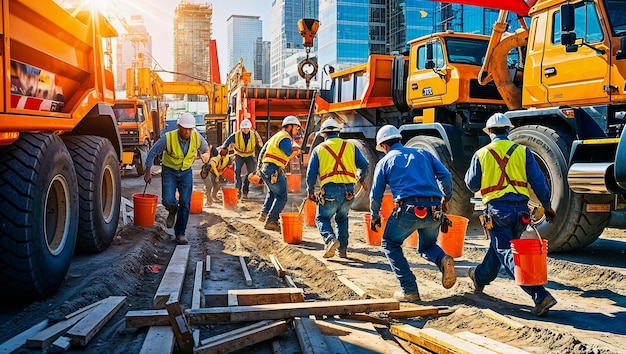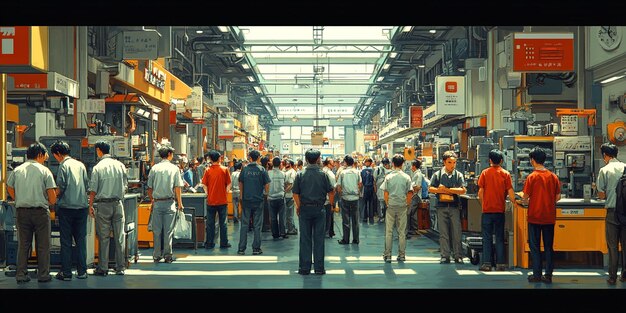Infrastructure Bill’s US Job Growth Impact: 12-Month Outlook

The New Infrastructure Bill is poised to significantly stimulate US job growth over the next 12 months, driven by substantial investments in public works, clean energy, and digital infrastructure, creating direct, indirect, and induced employment across various sectors.
The passage of the New Infrastructure Bill marks a pivotal moment for the American economy, with widespread anticipation regarding its potential impact. Many are asking: How the New Infrastructure Bill Will Impact US Job Growth in the Next 12 Months? This legislation, representing one of the largest federal investments in infrastructure in decades, is designed to modernize critical national systems while simultaneously creating a robust pipeline of jobs across diverse industries. Understanding the scope and immediate effects of these investments is crucial for businesses, workers, and policymakers alike, as it will shape the economic landscape for the foreseeable future.
Understanding the Core Components of the Infrastructure Investment and Jobs Act
The Infrastructure Investment and Jobs Act (IIJA), signed into law in November 2021, is a bipartisan bill allocating approximately $1.2 trillion over eight years, with about $550 billion designated as new federal spending. This monumental investment targets various sectors deemed critical for national economic competitiveness and quality of life. At its core, the bill aims to address long-standing deficiencies in American infrastructure, ranging from aging roads and bridges to outdated water pipes and insufficient broadband access.
The Act’s broad scope means its impact will be felt across virtually every state and municipality. Its design not only focuses on repairing existing structures but also on building new, resilient systems capable of withstanding future challenges, including climate change. This dual approach of repair and expansion lays the groundwork for sustained job creation beyond the immediate 12-month window.
Key Investment Areas and Their Immediate Job Implications
The bill outlines specific allocations for several vital areas. These targeted investments are expected to generate immediate and measurable employment opportunities.
- Transportation Sector: A significant portion is dedicated to roads, bridges, public transit, rail, ports, and airports. This means a surge in demand for civil engineers, construction workers, equipment operators, and logistics personnel.
- Water Infrastructure: Modernizing lead pipes and improving water quality will require plumbers, pipefitters, environmental engineers, and skilled laborers.
- Broadband Expansion: Connecting underserved communities necessitates technicians, network engineers, and construction crews for laying fiber optic cables.
- Clean Energy and Power Grid: Investments in renewable energy, energy efficiency, and grid resilience will create jobs for electrical engineers, renewable energy technicians, and utility workers.
The immediate implication for job growth within the first 12 months stems directly from the initiation of these projects. Grant applications are processed, contracts awarded, and groundbreaking ceremonies begin, leading to an almost instant uptick in demand for a wide range of skilled and unskilled labor. This initial phase is crucial, as it sets the precedent for the bill’s long-term success in stimulating employment.
Moreover, these investments are designed to kickstart local economies. Small and medium-sized businesses, particularly those in the construction and engineering fields, are expected to be primary beneficiaries, leading to localized hiring sprees. The sheer volume of projects dictates a broad geographical impact, preventing job growth from being concentrated in only a few regions. The initial rollout of funding and the beginning of project planning will be key indicators of the bill’s effectiveness in generating these early job gains.
Direct Job Creation: Construction, Engineering, and Skilled Trades
The most immediate and tangible effect of the New Infrastructure Bill on US job growth in the next 12 months will be seen in direct job creation. These are the positions directly involved in the physical execution of infrastructure projects. The construction industry, in particular, is poised for a significant boom, requiring a substantial influx of labor across multiple skill sets.
From the moment federal funds begin to flow, states and localities launch projects that demand an immediate workforce. This includes heavy equipment operators, electricians, plumbers, ironworkers, carpenters, and civil engineers. Many of these trades have faced workforce shortages, and the bill provides a much-needed impetus for vocational training and apprenticeships, creating pathways for new workers to enter these fields. The urgency to address deteriorating infrastructure means that project commencement will be swift, translating directly into job openings.
Projected Job Roles and Demand
Analysts project a sustained increase in demand for specific roles critical to infrastructure development.
- Civil Engineers: Essential for planning, designing, and overseeing complex projects like bridges and highways.
- Construction Managers: Required to coordinate daily operations, ensure safety, and keep projects on schedule and budget.
- Skilled Tradespeople: Electricians, welders, pipefitters, and crane operators will be in high demand for various construction and utility upgrade tasks.
- Laborers: General laborers will be needed for site preparation, material handling, and assistance with specialized tasks.
The ripple effect extends beyond traditional construction. For instance, the expansion of broadband infrastructure will require telecom technicians, network installers, and specialized construction crews for trenching and cable laying. Water infrastructure projects will call for specialized pipe welders, treatment plant operators, and environmental compliance officers. These roles often require specific certifications or training, highlighting the need for robust workforce development programs to meet the impending demand.
Furthermore, the increased workload in these sectors will likely necessitate hiring in support functions, such as human resources for recruitment, safety officers for compliance, and administrative staff. This initial wave of hiring is vital for establishing the foundation upon which subsequent indirect and induced job growth can build. The first 12 months will be characterized by aggressive recruitment and training efforts to staff up these critical projects, making direct job creation the most prominent feature of the bill’s early impact.
Indirect and Induced Job Growth: A Broader Economic Ripple Effect
Beyond the direct jobs created on construction sites, the New Infrastructure Bill is designed to generate significant indirect and induced job growth, extending its impact far beyond the immediate projects. These secondary and tertiary forms of employment are crucial for a holistic understanding of US job growth over the next 12 months and beyond. Indirect jobs are those created within the supply chain, while induced jobs result from the spending of newly employed workers.
Consider the massive demand for materials required for infrastructure projects: steel, concrete, asphalt, timber, and specialized machinery. This demand directly translates into increased production at manufacturing plants, quarries, and logistics companies, leading to hiring in these sectors. Truck drivers, factory workers, raw material extractors, and warehouse personnel will see increased opportunities as they support the primary construction efforts. This chain reaction amplifies the job creation effect, pulling diverse industries into the economic upswing.

Supply Chain Expansion and Service Sector Boost
The expansion of activity in the supply chain is a fundamental driver of indirect job growth. Manufacturers of construction equipment, components for renewable energy systems, and materials for road construction will scale up operations.
- Manufacturing: Increased production for construction materials, specialized tools, and machinery parts. Jobs range from assembly line workers to quality control inspectors.
- Logistics and Transportation: More demand for shipping, trucking, and delivery services to move materials and equipment to project sites.
- Professional Services: Accounting, legal, and consulting firms will see increased business from companies engaged in infrastructure projects.
Induced job growth arises as workers employed directly and indirectly spend their increased wages. When a construction worker buys lunch at a local diner, or a factory worker purchases new clothes, they stimulate demand in the retail, service, and hospitality sectors. Restaurants, grocery stores, salons, and entertainment venues will experience increased patronage, leading to hiring in these consumer-facing roles. This spending creates a virtuous cycle, where economic activity stimulates further economic activity.
The combined effect of indirect and induced job creation is often larger than direct job creation over time, though the first 12 months will see the initial stages of this ripple effect. As project pipelines become established, and confidence in sustained investment grows, businesses in supporting sectors will begin to invest and expand, leading to more permanent job gains. The integration of these various job types underscores the comprehensive economic strategy embedded within the Infrastructure Bill.
Regional Impact and Workforce Development Initiatives
The impact of the New Infrastructure Bill on US job growth is not uniform across the nation; it will manifest differently based on regional needs, existing infrastructure, and workforce readiness. Analyzing the regional implications and the accompanying workforce development initiatives is crucial for understanding the bill’s full employment potential within the next 12 months and beyond. States with significant aging infrastructure are poised for substantial investment, while areas lacking essential services like broadband will also see targeted development.
For instance, states with numerous structurally deficient bridges or old water systems will experience a concentrated influx of projects, leading to higher localized job growth in those areas. Conversely, rural areas struggling with digital divides will see significant engagement from broadband expansion efforts. This regional distribution ensures that the economic benefits of the bill are spread broadly, addressing specific needs while simultaneously creating jobs where they are most needed.
Addressing Workforce Gaps and Promoting Skilled Labor
A major challenge and opportunity lie in aligning the existing workforce with the demands of new infrastructure projects. Many skilled trades have faced persistent shortages, and the bill aims to mitigate this through targeted initiatives.
- Apprenticeship Programs: Increased funding and emphasis on registered apprenticeships to train a new generation of skilled workers in construction, manufacturing, and clean energy.
- Community College Partnerships: Collaborations with local educational institutions to develop specialized courses and certifications tailored to infrastructure project requirements.
- Workforce Re-entry Programs: Initiatives to help dislocated workers, veterans, and individuals from underserved communities gain the skills needed for these new jobs.
Within the first year, we can expect to see an acceleration in these workforce development initiatives. Partnerships between labor unions, educational institutions, and government agencies will be critical in rapidly upskilling the workforce. The goal is not just to fill immediate vacancies but to build a sustainable pipeline of talent capable of supporting long-term infrastructure needs.

Moreover, the bill’s emphasis on clean energy and climate resilience projects will spur demand for new, specialized skills. This includes technicians for solar and wind farms, engineers for smart grid development, and professionals capable of implementing sustainable construction practices. These emerging fields represent a significant area for future job growth, with initial training and hiring likely to begin within the first 12 months as preparatory work for larger projects commences. The regional focus ensures that specific community needs are met, leading to tailored job growth and skill development.
Challenges and Potential Headwinds for Job Growth
While the New Infrastructure Bill presents a robust opportunity for US job growth, it is not without its challenges and potential headwinds that could temper the immediate impact within the next 12 months. Understanding these obstacles is essential for a balanced perspective on the bill’s employment effects. Factors ranging from inflation to supply chain disruptions and labor availability could influence the pace and scale of job creation.
One primary concern is inflation. Increased demand for construction materials, coupled with existing supply chain bottlenecks, could drive up costs, potentially reducing the number of projects that can be completed with allocated funds. If the cost of steel, concrete, or raw materials continues to rise significantly, it might necessitate reevaluation of project scopes or timelines, indirectly affecting hiring rates. This economic pressure could lead to fewer jobs per dollar spent than initially projected, creating a drag on the overall employment impact.
Supply Chain Issues and Labor Shortages
The current global economic environment poses several challenges that could affect the rapid deployment of infrastructure projects.
- Material Shortages: Disruptions in global supply chains could delay the delivery of essential materials, pushing back project start dates and associated hiring.
- Skilled Labor Availability: Despite workforce development efforts, an immediate shortage of highly skilled workers in specific trades could slow down project execution.
- Inflationary Pressures: Rising costs for labor, materials, and transportation could squeeze project budgets, potentially leading to fewer projects or scaled-back ambitions.
Another significant challenge is the availability of skilled labor. While the bill includes provisions for workforce development, it takes time to train new workers and bring them up to speed. In the short term, contractors might struggle to find enough qualified individuals, especially for highly specialized roles. This could lead to competition for existing talent, increased wages (which itself contributes to inflation), or delays in project completion, all of which could limit the pace of job creation in the initial 12 months.
Bureaucratic hurdles and administrative delays also represent potential headwinds. The process of awarding grants, conducting environmental reviews, and securing necessary permits can be time-consuming. While efforts are being made to streamline these processes, large-scale federal projects inherently involve complex regulatory steps. Delays in these administrative phases could push back project start dates, thereby postponing the associated job creation. Navigating these challenges effectively will be critical to maximizing the bill’s employment benefits in the near term.
Sustainability and Long-Term Job Prospects Beyond 12 Months
While the immediate focus is often on US job growth in the next 12 months, the true measure of the New Infrastructure Bill’s success will be its ability to foster sustainable employment and enhance long-term economic prosperity. The initial surge in construction and related manufacturing jobs is a foundational step, but the bill also lays the groundwork for sustained job creation by modernizing systems and promoting new industries. This forward-looking approach ensures that the investments yield benefits that extend far beyond the initial project timelines.
Modernized infrastructure itself creates efficiencies that support existing businesses and attract new ones. Improved transportation networks reduce shipping costs and travel times, benefiting logistics companies and commuters alike. Enhanced broadband access opens up opportunities for remote work, e-commerce, and technological innovation in underserved areas. These systemic improvements create a more productive economy, which in turn fosters a stable environment for ongoing job creation in various sectors, including technology, healthcare, and education.
Building a Resilient Workforce for Future Needs
The bill is not just about building physical infrastructure; it’s also about building a resilient and adaptable workforce for future economic demands.
- Technological Integration: As infrastructure becomes “smarter” (e.g., smart grids, IoT-enabled transportation), demand for tech-savvy workers in maintenance, data analysis, and cybersecurity will grow.
- Clean Economy Transition: Investments in renewable energy and climate resilience will create a durable market for green jobs, from engineers and scientists to installation and maintenance technicians.
- Long-Term Maintenance: Once constructed, new and rehabilitated infrastructure will require ongoing maintenance, creating a steady demand for skilled trades and operational staff.
Furthermore, the focus on clean energy components within the bill is a strategic investment in future industries. By supporting the development of renewable energy sources and electric vehicle charging networks, the bill helps to transition the economy towards more sustainable practices. This transition will create entirely new sectors and job categories, independent of the initial construction phase. These “green jobs” are often well-paying and contribute to environmental sustainability, offering a dual benefit to society.
For the long term, the bill aims to prevent future infrastructure decay, thereby avoiding the need for repeated, massive investments solely for repairs. By building infrastructure that is more durable and resilient, and by integrating advanced technologies, the U.S. is creating a foundation for sustained economic activity and job stability. The investments in workforce development, particularly in emerging fields, ensure that the American labor force is prepared not only for today’s projects but also for the innovations and challenges of tomorrow, securing a lasting positive impact on employment.
Anticipated Economic Indicators and Metrics for Job Growth
To accurately gauge US job growth resulting from the New Infrastructure Bill over the next 12 months, it’s essential to monitor specific economic indicators and metrics. These data points will provide tangible evidence of the bill’s impact, helping policymakers, businesses, and the public understand its effectiveness. Tracking these metrics allows for adjustments and a clearer picture of the economic landscape as projects rollout.
The most direct indicator will be employment statistics within specific sectors. The Bureau of Labor Statistics (BLS) will be a critical source, reporting on job growth in construction, manufacturing, and transportation. A noticeable uptick in these categories, distinct from general economic recovery trends, would strongly suggest the bill’s influence. Additionally, unemployment rates, particularly for skilled trades, could reflect increased demand; a tightening labor market in these areas would signal robust hiring.
Key Metrics to Observe
Several data points will offer insights into the bill’s immediate and medium-term impacts.
- Nonfarm Payroll Employment: Monitoring monthly changes, especially in construction, manufacturing durable goods, and utilities sectors.
- Job Vacancy Rates: An increase in job postings for civil engineers, electricians, heavy equipment operators, and other key infrastructure roles.
- Wage Growth: While potentially an inflationary concern, significant wage growth in infrastructure-related fields could indicate high demand for labor.
- GDP Contributions from Construction: An increase in the construction sector’s contribution to real GDP would directly reflect the economic activity generated by the bill.
Beyond traditional employment figures, it will be important to observe the growth in new apprenticeship registrations and vocational training program enrollments. These numbers will reflect the success of workforce development initiatives aimed at bridging skill gaps. An increase in these programs would signal a healthy pipeline of future workers, ensuring sustained job growth beyond the initial 12-month period.
Furthermore, local and state economic development reports will offer granular data on project commencements and associated local hiring. Many states track job creation figures tied to specific grants or investments, providing a detailed, ground-level view of the bill’s impact. Monitoring these diverse indicators collectively will provide a comprehensive and nuanced understanding of how the Infrastructure Bill is shaping employment across the U.S. within its crucial first year of implementation.
| Key Point | Brief Description |
|---|---|
| 👷 Direct Job Creation | Significant demand for construction workers, engineers, and skilled trades across multiple projects. |
| 🔗 Indirect & Induced Growth | Supply chain expansion and increased consumer spending boost manufacturing and service sectors. |
| 🛠️ Workforce Development | Investments in training and apprenticeships to meet labor demands and address skill gaps. |
| ⚠️ Potential Headwinds | Inflation, supply chain issues, and labor shortages could temper immediate job growth. |
Frequently Asked Questions About Infrastructure and Job Growth
The bill is expected to create a wide range of jobs, predominantly in the construction sector, including civil engineers, heavy equipment operators, electricians, plumbers, and general laborers. Additionally, there will be increased demand for workers in manufacturing, logistics, and professional services that support these large-scale projects.
Many jobs are expected to become available quickly, within the first 12 months. As federal funds are dispersed and states launch projects, there will be an immediate demand for labor. However, some projects may face initial delays due to permits or material sourcing, pushing certain job creations further into the timeline.
Yes, implicitly. The bill includes significant investments in workforce development, apprenticeship programs, and partnerships with community colleges. These initiatives are designed to train new workers and upskill existing ones, helping to alleviate long-standing labor shortages in critical skilled trades and enhance the nation’s overall capacity.
Beyond direct construction, sectors like manufacturing (for materials and equipment), logistics and transportation, and professional services (engineering, legal, consulting) will see significant indirect job growth. Additionally, induced job growth will impact retail, hospitality, and local service industries as newly employed workers spend their wages across communities.
Key challenges include inflationary pressures on material and labor costs, ongoing global supply chain disruptions causing material shortages, and existing shortages of highly skilled workers. These factors could potentially slow down project timelines or reduce the overall number of jobs created if not effectively managed by stakeholders and policymakers.
Conclusion
The New Infrastructure Bill stands as a monumental investment poised to significantly reshape the landscape of US job growth over the next 12 months and beyond. While direct employment in construction and engineering will provide the immediate boost, the bill’s broader impact will be felt through indirect job creation across supply chains and induced growth in service sectors. Despite potential challenges such as inflation and labor shortages, targeted workforce development initiatives and a strategic focus on sustainable infrastructure development are designed to mitigate these hurdles. As funds are deployed and projects begin, the nation anticipates a robust and widespread increase in employment, laying a foundation for a more resilient and economically vibrant future.





